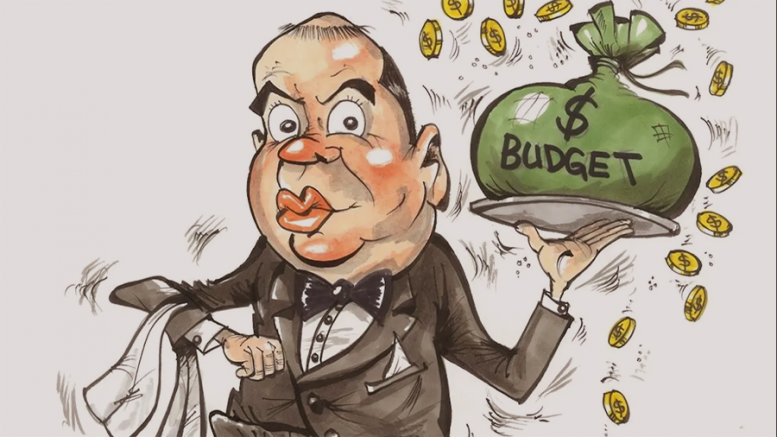Contributed by Joe Montero
The budget just delivered by treasurer Josh Frydenberg has strong elements of a war budget, together with an eye on the coming election and sugar coating to con the public that the Morrison government is delivering its promise of cost-of-living relief.
Both these faces of the election have their origin in the combination of the reality of economic stagnation, growing dissatisfaction and distrust among Australians over political leadership and institutions, and an increasingly uncertain world. Add on the government’s desperation to stay in office.
The graph below shows that the economy is heading back at the poor pre-Covid performance. The projections into the future are government estimations and highly likely to underplay the decline. Even without considering this, one would think the economy would have rated much more highly in this budget.
Military expenditure is the big winner. The government calls this protection in a more dangerous world. It is really about greater integration into the American military machine and confrontation with Russia and especially China. This is not defence but offence, designed to send Australian Defence Forces personnel and equipment overseas to service the American empire.
Military affairs always have their connection to politics and economics. In this case, it is being tied to an alliance with the superpower and dependency on Wall Street investors as the engine of the Australian economy.
A big $575 billion has been committed to the military, which amounts to 2 percent of Australia’s Gross Domestic Product (GDP). More will be spent on submarines, naval facilities, other equipment, and recruiting new personnel. A small part will go to buying into the conflict in Ukraine.
Compare this 2 percent to the total new budget expenditure of 3.4 percent of GDP. This tells the whole story. Frydenberg did not deliver a budget for people.
Under the title Redspice, Australia’s spy agencies will get an injection of $9.9 billion, to spy more on Australians and others, and there will be a massive increase in Internet and social media surveillance.
There is almost nothing in this budget to create jobs and strengthen the weak economy. Other than the military and security side, this is a budget designed to cover up real needs by pretending generosity. Take the pork barrelling of marginal electorates with millions in infrastructure money.
Excise on petrol will be halved from 44 cents a litre to 22 cents for 6 months. After this it will jump up again. Flood victims got the promise of help but got nothing for their immediate needs. Pensioners and other health card holders will get a one-off payment of $450. This will not be even enough to counter rising inflation expected to soon reach more than 4 percent and may continue to rise higher.

Photo by Flavio Brancaleone: Petrol excise cut is not enough to counter rising cost of living
The biggest con is the tax break of $450 for most and up to another $1,500 in July. Those with an income over $126,000 get the same. But this hides the losses and the fact that increasing costs will erode the benefit. Contrast this with the failure to do anything to encourage wage growth and counter the rise of precarious work. This would put more real dollars into most pockets.
Covid has made it politically essential for a government on the ropes to look like it is paying attention to the health system. Consequently, $4.2 billion has been allocated for this. The downside is that most, $1 billion for vaccines and $2.6 billion for personal protecting equipment will be sucked away by pharmaceutical companies and the private health corporations, leaving little to upgrade the overall health system.
Medicare spending will rise a little, except that much of this will be used to invest in substituting face to face service with teleservice delivered by private contractors.
A major negative in the budget is the commitment to increase coal production and expenditure on carbon reduction and sustainable development is cut from the low $2 billion to $1.9 billion with further cuts in the pipeline for the next 3 years.
The future of the economy and wellbeing of people are in grave risk without stepping up in climate action. The budget has shown that the Morrison government intends to keep on walking away from this responsibility.
It remains, the bill for military expenditure and opportunistic handouts will blow the government $1 trillion into the red. Someone will have to pay for this. In a situation where the gap between government expenditure and revenues is widening, there will be major spending cuts in the pipeline – held off until after the election. See the graph below.
Australia needs an alternative type of budget. One that is genuinely is for people. Such a budget would have two sides. It would raise revenue by ensuring that all contributed a fair amount of tax based on their capacity and impose adequate controls over finance. It would genuinely tackle the rising cost of living by assisting the rise of wages and creating new dull time jobs, increasing social security entitlements, and spending more on the public health and education systems.
A budget for people would deliver much more for combatting climate change and the emergence of a sustainable economy, as a driving force to build the future.
A budget for people would not spend on upgrading integration into the American military. It would devote resources to the promotion of peace and improving relations with all nations.
None of this will come through the Morrison government.
A coming article will provide alternative suggestions in more detail.


Be the first to comment on "Australia got a Budget for war and the privileged: Not for most Australians"